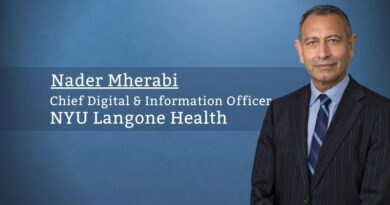Driving the Future of Healthcare: The Crucial Role of Clinical End-User Adoption in Achieving Digital Transformation
By Kristen Hagerman RN-BC, MS, VP Clinical Informatics and Chief Clinical Informatics Officer, Kaleida Health
The essence of digital transformation lies not just in deploying cutting-edge solutions, but in ensuring that these solutions are embraced and integrated seamlessly into the workflow by clinicians who use them every day. End-user adoption isn’t a side note or check box on a project plan; it’s the linchpin that determines the transformation’s success
At its core, end-user adoption refers to the degree to which clinicians embrace and effectively utilize new digital tools and technologies. These tools range from electronic health records (EHRs) and telemedicine platforms to data analytics and AI-powered solutions.
As we continue to revolutionize healthcare through digital transformation, clinician end-user adoption is the heartbeat that sustains progress.
Innovation and resistance: addressing the pain points
The healthcare industry, by its very nature, is a realm where innovation coexists with deeply ingrained traditions. Clinicians have honed their practices over the years, often developing routines that may resist change. Providers, nurses, and clinicians already burdened with demanding schedules and complex workflows might view technology adoption as an additional burden. In this dynamic, digital transformation introduces a paradox: the innovative potential of technology versus the resistance to alter established workflows. By comprehending these concerns, IT leaders can design solutions that mitigate disruptions, streamline processes, and create a symbiotic relationship between technology and patient care. Bridging this gap is where end-user adoption steps onto the stage.
Addressing this resistance requires a multifaceted approach. As IT leaders, our role is not just to implement technology but to inspire a cultural shift that embraces innovation and demonstrates how digital tools can simplify processes, save time, and enhance patient care. Open communication channels, continuous feedback loops and a supportive leadership team can help allay fears and concerns. Highlighting success stories and showcasing tangible benefits also aids in overcoming resistance and generating excitement around digital transformation.
Engaging the clinical end users from inception
Clinical end-user engagement should begin at the inception of any digital transformation initiative. Including representatives from various user groups in the planning and decision-making processes ensures that the technology aligns with their needs. Their input provides valuable insights into potential challenges and opportunities, thus increasing the likelihood of successful adoption.
User-centric design is the backbone of successful clinical end-user adoption. When technology aligns with the natural workflow of clinicians, it becomes an enabler rather than an obstacle. User experience (UX) considerations, such as intuitive interfaces and user-friendly features, play a pivotal role in minimizing the learning curve and maximizing user engagement.
End-user adoption extends beyond clinicians to encompass patients as well. Patient engagement is a cornerstone of modern healthcare, and digital tools play a pivotal role in enabling patients to actively participate in their own care. From patient portals and mobile apps to remote monitoring devices, these technologies empower patients to access information, schedule appointments, and manage their health conditions more effectively.
Tailored training and education
One of the most effective strategies for fostering clinical end-user adoption is through comprehensive training and education. When clinicians understand how a new technology aligns with their responsibilities and enhances patient outcomes, they are more likely to embrace it. A well-designed training program and budget to support it ensures that users are comfortable with the technology and equipped to navigate any challenges.
Regular check-ins, feedback loops, and dedicated support channels provide a safety net, reassuring end users that concerns are heard and addressed. A one-size fits all approach often leads to missed opportunities and frustrated users. Showing tangible benefits is crucial to win over hesitant users.
When providers, nurses, clinicians and other healthcare professionals witness how digital tools enhance their efficiency, accuracy and patient outcomes, the value proposition becomes self-evident. Sharing stories, showcasing data-driven improvements, and offering quantifiable metrics create a compelling case for end-user adoption.
Leadership’s role in shaping adoption
Effective leadership is a linchpin in driving end-user adoption. Healthcare executives and IT leaders must champion the transformation together, emphasizing its positive impact on patient care, operational efficiency, and the clinician/patient experience. Leaders should set a precedent by actively embracing the technology themselves and showcasing their commitment to the transformation.
Measuring the success of end-user adoption is crucial. Key performance indicators (KPIs) could include metrics like utilization rates, time saved, and patient outcome improvements. Regular assessments allow IT leaders to identify bottlenecks, areas of resistance, and opportunities for improvements. Iterative adjustments based on clinician feedback and evolving needs ensure that the digital transformation remains aligned with end-user requirements. End-user adoption is an ongoing process, not a one-time event. This iterative approach not only refines the technology but also reinforces the message that clinical end users are valued stakeholders in the transformation journey.
As we continue to revolutionize healthcare through digital transformation, clinician end-user adoption is the heartbeat that sustains progress. Fostering a culture of continuous learning, collaboration, and empowerment – a culture where clinicians are not just passive recipients, but active participants in shaping the future of healthcare is key. Through thoughtful strategies that address resistance, prioritize user-centric design, and engage end users at every step, the healthcare industry can unlock the true potential of digital transformation and usher in a new era of patient-centered, technologically enabled care.



